Scientific name Yutyrannus Rank Genus | Phylum Chordata Higher classification Tyrannosauroidea | |
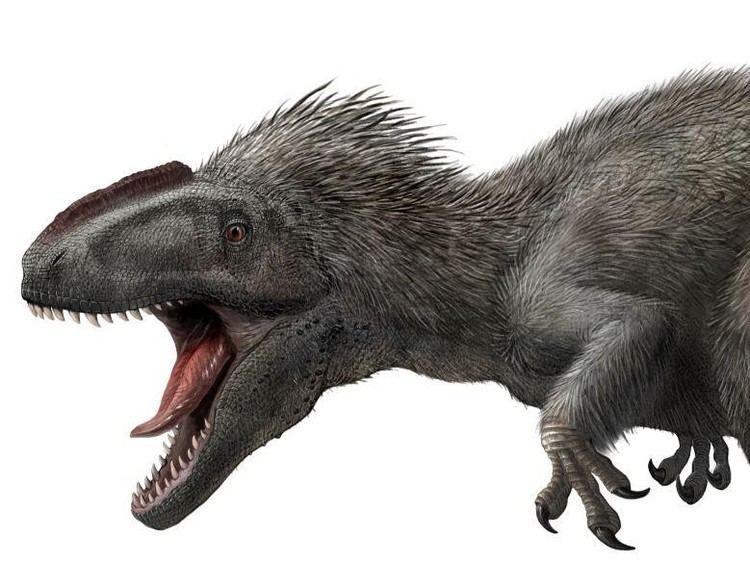 | ||
Similar Dinosaur, Tyrannosauroidea, Theropods, Dilong, Beipiaosaurus | ||
Yutyrannus vs deinocheirus dinosaur claymation fight
Yutyrannus (meaning "feathered tyrant") is a genus of tyrannosauroid dinosaurs which contains a single known species, Yutyrannus huali. This species lived during the early Cretaceous period in what is now northeastern China. Three fossils of Y. huali - all found in the rock beds of Liaoning Province - are currently the largest known dinosaur specimens that preserve direct evidence of feathers.
Contents
- Yutyrannus vs deinocheirus dinosaur claymation fight
- Paleo profile yutyrannus
- Discovery and namingEdit
- DescriptionEdit
- FeathersEdit
- PhylogenyEdit
- PaleobiologyEdit
- References

Paleo profile yutyrannus
Discovery and namingEdit
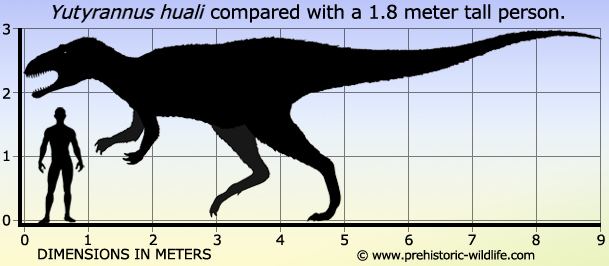
Yutyrannus huali was named and scientifically described in 2012 by Xu Xing et al. The name is derived from Mandarin Chinese yǔ (羽, "feather") and Latinised Greek tyrannos (τύραννος, "tyrant"), a reference to the classification as a feathered member of the Tyrannosauroidea. The specific name consists of the Mandarin huáli (华丽(simplified, 華麗 traditional, "beautiful"), in reference to the beauty of the plumage.
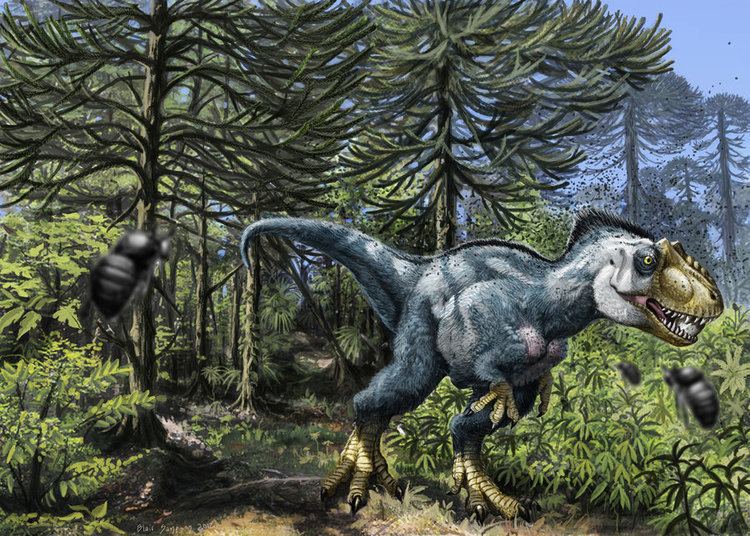
Yutyrannus is known from three nearly complete fossil specimens (an adult, a subadult and a juvenile) acquired from a fossil dealer who claimed all three had their provenance in a single quarry at Batuyingzi in Liaoning Province, China. They thus probably were found in a layer of the Yixian Formation, dating from the Aptian, approximately 125 million years old. The specimens had been cut into pieces about the size of bath mats, which could be carried by two people.
The holotype, ZCDM V5000, is the largest specimen, consisting of a nearly complete skeleton with skull, compressed on a slab, of an adult individual. The paratypes are the two other specimens: ZCDM V5001 consisting of a skeleton of a smaller individual and part of the same slab as the holotype; and ELDM V1001, a juvenile estimated to have been eight years younger than the holotype. The fossils are part of the collections of the Zhucheng Dinosaur Museum and the Erlianhaote Dinosaur Museum but have been prepared by the Institute of Vertebrate Paleontology and Paleoanthropology, under guidance of Xu.
DescriptionEdit
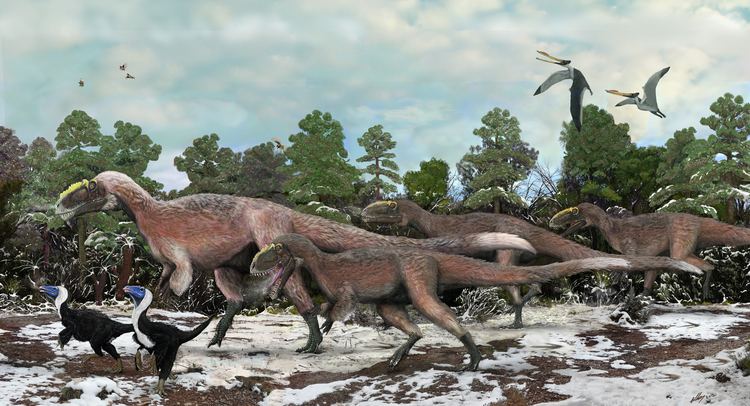
Yutyrannus were gigantic bipedal predators. The holotype and oldest known specimen has a length of 9 metres (30 ft) and an estimated weight of about 1,414 kg (3,117 lb). Its skull has an estimated length of 905 millimetres (35.6 in). The skulls of the paratypes are 80 centimetres (31 in) and 63 centimetres (25 in) long and their weights have been estimated at 596 kilograms (1,314 lb) and 493 kilograms (1,087 lb) respectively.
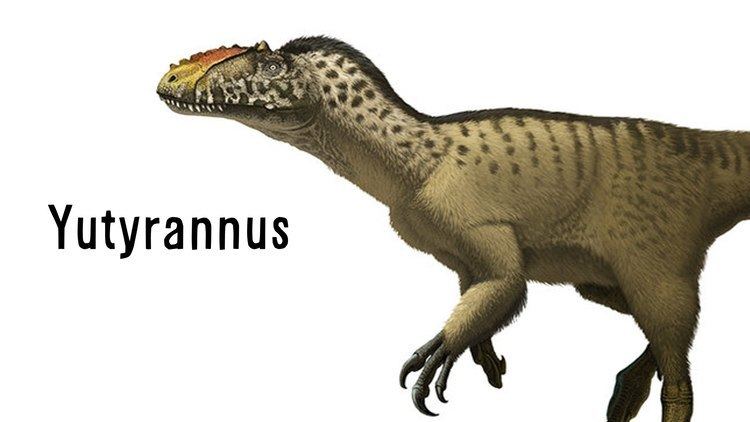
The describers established some diagnostic traits of Yutyrannus, in which it differs from its direct relatives. The snout features a high midline crest, formed by the nasals and the premaxillae and which is covered by large pneumatic recesses. The postorbital has a small secondary process, jutting into the upper hind corner of the eye socket. The outer side of the main body of the postorbital is hollowed out. In the lower jaw, the external mandibular fenestra, the main opening in the outer side, is mainly located in the surangular.
FeathersEdit
While it has been known since 2004, upon the description of Dilong, that at least some tyrannosauroids possessed filamentous "stage 1" feathers, according to the feather typology of Richard Prum, Y. huali is currently the largest known species of dinosaur with direct evidence of feathers, forty times heavier than the previous record holder, Beipiaosaurus. The feathers were long, up to 20 centimetres (7.9 in), and filamentous. Because the quality of the preservation was low, it could not be established whether the filaments were simple or compound, broad or narrow. The feathers covered various parts of the body. With the holotype they were present on the pelvis and the foot. Specimen ZCDM V5000 had feathers on the tail pointing backwards under an angle of 30° with the tail axis. The smallest specimen showed 20 centimetre (7.9 inch)-long filaments on the neck and 16 centimetre (6.3 inch)-long feathers at the upper arm.
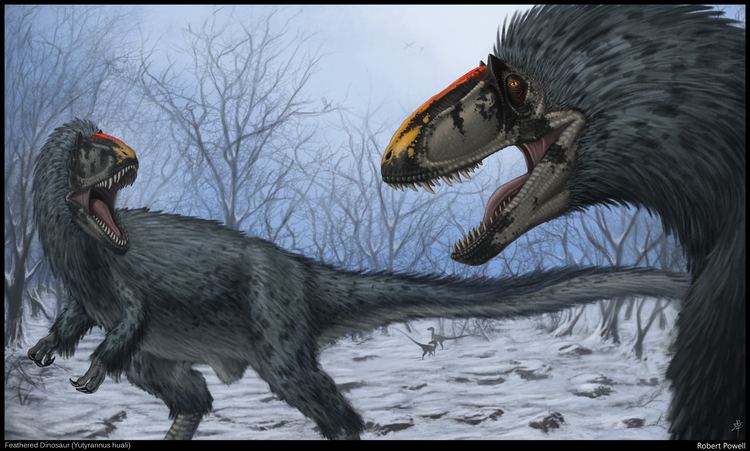
Based on the distribution of the feathers, they may have covered the whole body and served in regulating temperature, given the rather cold climate of the Yixian with an average annual temperature of 10 °C (50 °F). Alternatively, if they were restricted to the regions in which they were found, they may have served as display structures. In addition, the two adult specimens had distinctive, "wavy" crests on their snouts, on both sides of a high central crest, which were probably used for display. The presence of feathers on a large basal tyrannosauroid suggests the possibility that later tyrannosaurids were also feathered, even when adult, despite their size. However, scaly skin impressions have been reported from various Late Cretaceous tyrannosaurids (such as Gorgosaurus, Tarbosaurus and Tyrannosaurus) on parts of the body where Yutyrannus was feathered. Since there is no positive evidence for plumage in tyrannosaurids, some researchers have suggested they may have evolved scales secondarily. If scaly skin was the dominant epidermal trait of later genera, then the extent and nature of the integumentary covering may have changed over time in response to body size, a warmer climate, or other factors.
PhylogenyEdit
To date, all phylogenetic analyses of Yutyrannus' relationships have classified it in the group Tyrannosauroidea. An initial analysis of its relationship to other tyrannosauroids showed that it was more primitive than Eotyrannus in the evolutionary tree, but more advanced than tyrannosauroids such as Dilong, Guanlong and Sinotyrannus. Primitive traits relative to advanced tyrannosaurs included long forelimbs with three fingers and a short foot which was not specialized for running. Advanced traits included a large and deep skull, the outer side of the premaxilla having rotated upwards, a large cuneiform horn on the lacrimal in front of the eye socket, a postorbital process on the back rim of the eye socket, the squamosal and the quadratojugal forming a large process on the back rim of the infratemporal fenestra, short dorsal vertebrae, an ilium with a straight upper rim and an appending lobe, a large pubic foot and a slender ischium.
In 2016, a phylogenetic analysis conducted by Thomas Carr and Stephen Brusatte re-examined the evolutionary relationships of the Tyrannosauroidea. Their analysis found Yutyrannus to be more basal than Dilong, placing it within the family Proceratosauridae.
PaleobiologyEdit
The knowledge of specimens representing various different ages has allowed paleontologists to determine the ontogeny, or change during growth, of this species. During growth the lower legs, feet, ilia and forelimbs became relatively smaller. The skull, on the other hand, grew more robust and deeper.
